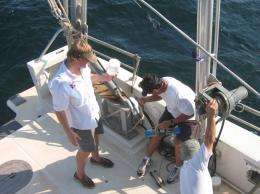NASA Heads Out to Sea

NASA scientists Maury Estes and Mohammad Al-Hamdan have been seafaring in the Gulf of Mexico, and one of them grew a bit green around the gills. It's not surprising that a space agency scientist might have trouble getting his sea legs, but what was he doing out there in the surf to begin with?
"We were gathering water samples," explains Estes.
That doesn't sound much like rocket science, but consider the following:
At this moment, a fleet of NASA Earth-observing satellites is silently passing overhead, gathering vital information about our planet. Estes and Al-Hamdan are combining that heavenly data with local water samples to help the Mobile Bay National Estuary Program, or NEP, check the health of the coast.
"We're most interested in sea grass and marine vegetation," says Al-Hamdan. "A region's plant health tells you a lot about the health of the area itself." "It's fair to say that if seagrass is in trouble, so is everything else in the area," explains Dr. Ken Heck of the Dauphin Island Sea Lab in Mobile. "Sea grass beds provide shelter and food for many ecologically and economically important fish and shellfish, and even for the manatee - an endangered gentle giant that regularly visits Mobile Bay. These beds also stabilize the shoreline, prevent erosion, and even help filter and cleanse the water that enters our estuaries from the watershed."
According to Estes and Al-Hamdan, the way the land is used throughout the watershed influences how much fresh water flows into the salt water areas and what that fresh water contains. Homes, farms, forests, small towns, big cities, etc., all affect the water in distinctive ways. "For instance, sediments cloud the fresh water flow," explains Estes. "And fertilizers can boost invasive species and algae that choke out the 'good' plants like sea grass."
"So we knew we'd get environmentally valuable information by looking at how the land was used in the past and how it's used now," says Al-Hamdan. "Historical NASA satellite data told us what we wanted to know."
That "heavenly" data, along with local water samples, revealed land use-related trends in water flow quality and properties like salinity, temperature, and clarity. These factors have both a literal and figurative trickle-down effect on marine plant life and therefore overall habitat health.
"This research helps us model, or predict, how different types of land use might affect the coastal environment in the future, not only in the Mobile Bay area but also in other coastal areas," says Al-Hamdan.
"The work NASA's doing will help coastal resource managers direct the limited resources available for habitat conservation and restoration," says Mobile Bay NEP Director Roberta Swann. "It will help us focus restoration efforts where they’re most needed and most likely to succeed."
When Estes and Al-Hamdan aren't in the office poring over satellite images to help foresee the coastal future, they're heading out to sea, where they collect water samples to analyze for "ground truth" to validate their model. The ocean voyages also give them a first-hand view of what they're studying and why.
"You do science in the real world -- not in the office," explains Estes. "Going out there gives you a good perspective on the research data. If you don't physically know the area you're studying, it limits your understanding."
"From the boat, we got to see the coastal areas we're targeting. Turns out that the northern third of the Mobile Bay environment is natural shore, but the southern two thirds is primarily sea walls, rip raps (man-made piles of big rocks), and revetments (sea wall /rip raps combination). Plant and animal life can’t flourish in rocks and concrete."
Estes sees the modification of natural coastline as a self-perpetuating problem.
"Development feeds on itself," says Estes. "If your neighbor builds a sea wall to help protect his own shore from eroding, your shore starts eroding, so you put up a sea wall too. And it's much more difficult to get a permit to restore a natural beach or marsh area on one's property than to get permission to build a sea wall. Plus there are all kinds of docks and boat launches along the coast."
The scientists spent an entire day, recently, on the open ocean gathering water samples and mentally cataloging the coast line. They're quite serious about their work but will take a few moments for fun.
"I got a nice tan out in the boat," jokes Al-Hamdan. "It beats green."
Provided by JPL/NASA (news : web)

















